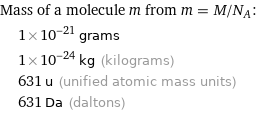Input interpretation

titanium(IV) phthalocyanine dichloride | molar mass
Result

Find the molar mass, M, for titanium(IV) phthalocyanine dichloride: M = sum _iN_im_i Plan: • Write the chemical formula and gather atomic masses from the periodic table. • Determine values for N_i and m_i using these items. • Finally, compute the mass. Write the chemical formula: C_32H_16Cl_2N_8Ti Use the chemical formula to count the number of atoms, N_i, for each element: | N_i C (carbon) | 32 Cl (chlorine) | 2 H (hydrogen) | 16 N (nitrogen) | 8 Ti (titanium) | 1 Look up the atomic mass, m_i, in g·mol^(-1) for each element in the periodic table: | N_i | m_i/g·mol^(-1) C (carbon) | 32 | 12.011 Cl (chlorine) | 2 | 35.45 H (hydrogen) | 16 | 1.008 N (nitrogen) | 8 | 14.007 Ti (titanium) | 1 | 47.867 Multiply N_i by m_i to compute the mass for each element. Then sum those values to compute the molar mass, M: Answer: | | | N_i | m_i/g·mol^(-1) | mass/g·mol^(-1) C (carbon) | 32 | 12.011 | 32 × 12.011 = 384.352 Cl (chlorine) | 2 | 35.45 | 2 × 35.45 = 70.90 H (hydrogen) | 16 | 1.008 | 16 × 1.008 = 16.128 N (nitrogen) | 8 | 14.007 | 8 × 14.007 = 112.056 Ti (titanium) | 1 | 47.867 | 1 × 47.867 = 47.867 M = 384.352 g/mol + 70.90 g/mol + 16.128 g/mol + 112.056 g/mol + 47.867 g/mol = 631.30 g/mol
Unit conversion

0.6313 kg/mol (kilograms per mole)
Comparisons

≈ 0.88 × molar mass of fullerene ( ≈ 721 g/mol )

≈ 3.3 × molar mass of caffeine ( ≈ 194 g/mol )

≈ 11 × molar mass of sodium chloride ( ≈ 58 g/mol )
Corresponding quantities

Mass of a molecule m from m = M/N_A: | 1×10^-21 grams | 1×10^-24 kg (kilograms) | 631 u (unified atomic mass units) | 631 Da (daltons)

Relative molecular mass M_r from M_r = M_u/M: | 631